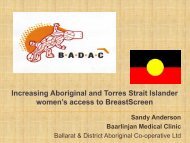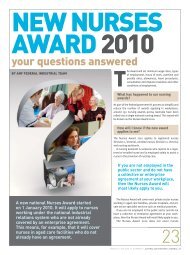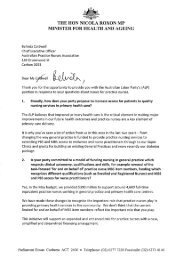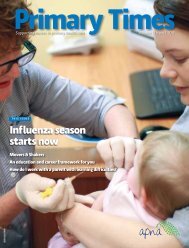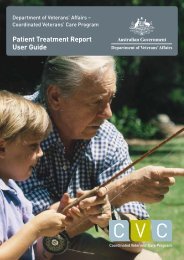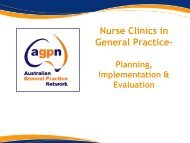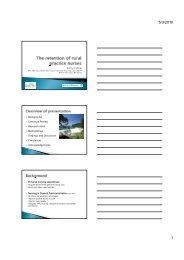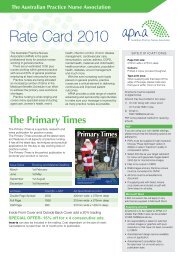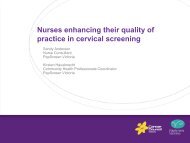September - APNA
September - APNA
September - APNA
Create successful ePaper yourself
Turn your PDF publications into a flip-book with our unique Google optimized e-Paper software.
CLINICAL CARE<br />
1. Express empathy 2. Develop discrepancy 3. Roll with resistance 4. Support Self-Efficacy<br />
Accept where the patient is at Use decisional balance Avoid argument Acceptance<br />
Use reflective listening Confidence and importance ratings Reframe Positive reinforcement and encouragement<br />
Work with ambivalence Direct the intentiontowards change Reflect Acknowldege past successes (even part-success)<br />
Elaboratewith the patient<br />
Involve the patient in problem solving<br />
Table 1. Principles and Strategies of Motivational interviewing.<br />
Confidence<br />
10<br />
9<br />
8<br />
7<br />
6<br />
5<br />
4<br />
3<br />
2<br />
1<br />
0<br />
1 2 3 4 5 6 7 8 9 10<br />
Figure 1. Importance, confidence and readiness to change.<br />
a scale from 1 to 10 How confident<br />
would you say you are that you could<br />
stop smoking on the same scale<br />
from 1 to 10 It also builds on the<br />
patient’s sense of autonomy, keeping<br />
the focus on what they believe and<br />
feel, not what the nurse or GP<br />
believes. If the patient scores low, a<br />
follow-up question could be asked<br />
about what they believe would help<br />
move them further along the scale.<br />
These questions can also open up<br />
the space for a ‘patient centred’ yet<br />
directive dialogue between nurse<br />
and patient, exploring the patient’s<br />
ambivalence and helping build<br />
motivation for change. The aim is<br />
to work collaboratively with the<br />
patient, avoiding direct confrontation.<br />
Miller and Rollnick 9 describe<br />
four principles of MI, each of which<br />
is supported by a range of strategies<br />
(see Table 1).<br />
Expressing empathy involves<br />
using all our previous training in<br />
good basic communication skills.<br />
Attending well to the patient, using<br />
an open posture, employing skilful<br />
and reflective listening and<br />
summarising back what the patient<br />
said will all help build a sense of<br />
empathy and understanding with<br />
the patient. Similar skills are used in<br />
affirming the patient’s efforts and<br />
Importance<br />
building his/her self-efficacy and<br />
confidence about the future.<br />
Developing discrepancy means<br />
building on the dialogue that starts<br />
with the importance and confidence<br />
questions. The aim is to help<br />
patients clarify important goals<br />
for themselves and to explore the<br />
consequences of their current<br />
behaviour, pointing out that there<br />
may be a discrepancy between these<br />
consequences and the goals they<br />
may have. Exploring both sides of<br />
the equation is what is meant by a<br />
‘decisional balance’. Again, talking<br />
about smoking is a good example.<br />
Key open questions can be: What<br />
are all the good things you enjoy<br />
about smoking What are some<br />
of the less good things about your<br />
smoking Helping the patient to<br />
make this an extensive list can<br />
give you a chance to weave in<br />
information about the known harms<br />
and health damaging effects of<br />
smoking. If the patient can’t identify<br />
many negatives, additional questions<br />
could be: What is there about your<br />
smoking that other people might see<br />
as reasons for concern What are<br />
some of the hassles that your<br />
smoking may have caused How<br />
does your smoking fit in with your<br />
diabetes/asthma/hypertension<br />
Generating positive talk from the<br />
patient about the possibility of<br />
change can be useful, with questions<br />
such as: What are the things that<br />
you would like to have in your life<br />
instead of tobacco If you did make a<br />
change to your lifestyle, how would<br />
you like things to turn out Who are<br />
the people in your life that would<br />
support you in quitting<br />
Rolling with resistance means<br />
reframing barriers that the patient<br />
may raise. ‘I couldn’t get through all<br />
the stress at work without smoking!’<br />
might be reframed as ‘It’s good that<br />
you have managed to identify some<br />
of the triggers that keep you<br />
smoking. Let’s think about how we<br />
could help you deal with that stress’.<br />
Motivational interviewing will<br />
not be suitable for all people or all<br />
situations. But it can be a useful<br />
strategy to employ when you have<br />
reached a block with a patient<br />
around a lifestyle behaviour that<br />
seems to be a problem. It can help<br />
you get beyond assumptions you may<br />
be making subconsciously that this<br />
patient is being ‘difficult’ and should<br />
take your advice now and change his/<br />
her lifestyle. It can generate new<br />
ideas for both you and the patient.<br />
The skill is to weave it into the<br />
complex ongoing relationship that<br />
develops between a practice nurse<br />
and a patient over time.<br />
References<br />
1. Commonwealth Department of Health<br />
and Aged Care. Building a 21st Century<br />
Primary Health Care System: Australia’s<br />
First National Primary Health Care<br />
Strategy. Canberra: Commonwealth<br />
Department of Health and Aged<br />
Care; 2010.<br />
2. Commonwealth Department of Health<br />
and Aged Care. Taking Preventative<br />
Action — A Response to Australia:<br />
The Healthiest Country by 2020 —<br />
The Report of the National Preventative<br />
Health Taskforce. Canberra:<br />
Commonwealth Department of Health<br />
and Aged Care; 2010.<br />
3. Britt H, Miller G, Charles J, Henderson J,<br />
Bayram C, Pan Y, et al. General practice<br />
activity in Australia, 2008–09. Canberra:<br />
AIHW; 2009.<br />
4. The Royal Australian College of General<br />
Practitioners National Standing<br />
Committee — Quality Care. Smoking,<br />
Nutrition, Alcohol and Physical activity<br />
(SNAP): A population health guide to<br />
behavioural risk factors in general<br />
practice. Melbourne: RACGP; 2004.<br />
5. Halcomb E, Moujalli S, Griffiths R,<br />
Davidson P. Effectiveness of general<br />
practice nurse interventions in cardiac<br />
risk factor reduction amongst adults:<br />
A systematic review. International<br />
Journal of Evidence-Based Healthcare.<br />
2007;5(3):269–295.<br />
6. Ashenden R, Silagy C, Weller D.<br />
A systematic review of the effectiveness<br />
of promoting lifestyle change in general<br />
practice. Fam Pract. 1997;14(2):160–176.<br />
7. Lai D, Cahill K, Qin Y, Tang J.<br />
Motivational interviewing for smoking<br />
cessation. Cochrane Database of<br />
Systematic Reviews. 2009(1).<br />
8. Rubak S, Sandboek A, Lauritzen T,<br />
Christensen B. Motivational interviewing:<br />
a systematic review and meta-analysis.<br />
Br J Gen Pract. 2005;55(513):305–312.<br />
9. Miller WR, Rollnick S. Motivational<br />
interviewing: preparing people for<br />
change. 2nd ed. New York: Guilford<br />
Press; 2002.<br />
Dr John Furler MBBS, FRACGP, PhD<br />
Senior Research Fellow Primary Care Research Unit<br />
Department of General Practice The University of<br />
Melbourne<br />
<strong>September</strong> 2010 Primary Times 15



